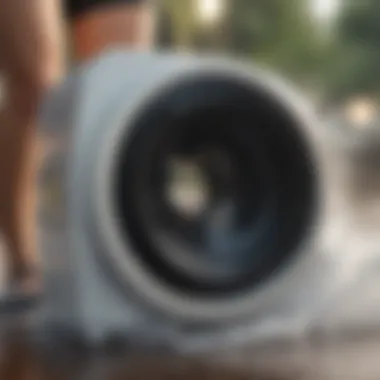Understanding Longboard Washers for Better Performance


Intro
Longboarding is more than just a leisure activity; it’s a way of life for many adrenaline seekers. While enthusiasts often focus on boards and trucks, one component that deserves the spotlight is the longboard washer. These sometimes overlooked pieces are critical for optimized performance, safety, and maintenance. Understanding longboard washers enables riders to elevate their skills while ensuring a smoother ride.
In this guide, we will venture into the world of longboard washers, covering everything from the material composition to their compatibility with various setups. We’ll also highlight maintenance practices that keep your gear in top-notch shape. Whether you’re a novice just stepping onto a board or a seasoned rider seeking to fine-tune your performance, this guide aims to enrich your understanding and riding experience.
Understanding Longboard Washers
Longboard washers may not be the first thing that comes to mind when one thinks of the intricacies of longboarding, yet they serve a crucial function in ensuring the overall performance and safety of the ride. For avid extreme sports enthusiasts, awareness and understanding of each component can significantly determine the smoothness of the glide, control over the board, and ultimately, the rider's experience. With numerous setups available in the market, it's imperative to grasp just how integral washers are in this equation.
Definition and Purpose
Simply put, a washer is a small disk, often made of metal or plastic, that is placed between the nut and the component being fastened. In the realm of longboarding, these seemingly minor pieces have a defining impact. Their primary purpose is to distribute the load of the bolt or screw evenly across a surface, minimizing wear and damage to the components involved. Essentially, this prevents issues that could arise from vibration or loosening due to movement, keeping everything securely locked in place.
Additionally, washers can offer a unique surface for grip, influencing the responsiveness of the ride. Without properly fitted washers, a longboard can experience rattling or loosening, which can lead to unfortunate accidents—an undesirable thought for anyone riding downhill or attempting tricks.
The Role of Washers in Longboarding
Washers hold more significance in longboarding than one might assume. They act as an intermediary buffer between the various components of the longboard, particularly in the truck assembly. This function becomes increasingly vital when considering different riding styles, which directly impact the choice of washers.
- Stability: In competitive racing, where precision is key, the right washer can help maintain stability under high speeds.
- Vibration Absorption: For those tackling rough terrain or practicing tricks, washers can absorb some of the vibrations that occur, ultimately protecting your board from excessive wear.
- Safety: A loose bolt can lead to disastrous outcomes; thus, the washer plays a critical role in preventing such tragedies.
Much like choosing the right wheels or deck, choosing the appropriate washers can enhance your longboarding experience, reflecting the importance of this small yet impactful component.
Types of Washers
When it comes to longboarding, the right washer can play a key role in how your ride feels. Underestimating their importance could lead to a frustrating experience. Washers aren't just there for show; their design significantly impacts the performance and safety of your longboard. Let’s take a closer look at the various types of washers you might encounter and how each one serves a distinct purpose.
Flat Washers
Flat washers are perhaps the most basic and common type you'll come across. Their role is simple yet crucial, acting as a buffer between nuts and the surface of the longboard. Flat washers help distribute the load of the fastener, thereby preventing damage to the deck or truck. Choosing the right thickness and diameter is important, as a washer that’s too thin might not provide enough support, while one too thick could create unnecessary bulk.
"For any avid longboarder, investing in decent flat washers can mean the difference between a smooth ride and constant tightening of loose bolts."
When you opt for flat washers, consider materials. Metal washers, for example, tend to be more durable and can handle a lot of wear and tear, making them perfect for downhill riding. But if you’re opting for a lighter setup, perhaps for cruising, plastic washers could be a great alternative; they help cut down on weight while still providing adequate support.
Locking Washers
Locking washers take things a step further. Their unique design prevents loosening over time, even as you hit those bumps and dips on your favorite trails. These washers usually come in two varieties: split-lock and toothed. Split-lock washers have a slightly bent edge that presses against the nut and the surface, creating tension. Toothed washers, on the other hand, have jagged edges that grip onto the surface, making them difficult to move once tightened.
Using locking washers is especially beneficial for extreme riders, where sudden jolts and vibrations are the name of the game. Without them, you might find your bolts becoming loose after just a few rides, which can lead to a potential accident. It's worth mentioning that while they offer excellent prevention against loosening, you still need to check them regularly, as no system is foolproof.
Conical Washers
Conical washers, often less well-known, have a shape that sets them apart from the standard options. Their unique, angled design optimizes the load distribution against the surface of the deck and the truck. This special characteristic allows for exceptional engagement with the surfaces they touch. Thus, minimizing the chances of damage and increasing longevity.
These washers are particularly useful in setups where the angle of the truck might cause extra pressure on the components. For instance, if you're riding a board that features a steep angle on the trucks, conical washers can help maintain stability, reducing the likelihood of slipping components during rides. If you are into techy longboarding styles or tricks where precision is key, consider integrating conical washers into your setup.
Materials Used in Washers
Understanding the materials used in longboard washers is pivotal since they are the unsung heroes that contribute significantly to overall performance and safety. Each type of washer material possesses distinct properties that can affect how well your longboard rides. Choosing the right material isn't just about preference; it can make or break your riding experience. This section will elucidate the key materials used in longboard washers and their respective benefits, considerations, and impacts on performance.
Metal Washers
Metal washers are often favored for their durability and strength. Crafted from materials like stainless steel or aluminum, they can withstand harsher conditions and provide superior support to your longboard setup. For instance, if you're gliding downhill at breakneck speed or taking sharp turns, metal washers offer the robust performance that many riders desire.
- Strength: Thanks to their sturdy construction, they excel at resisting deformation under pressure.
- Longevity: Metal has a longer lifespan compared to other materials, which can be an economic advantage.
However, there are considerations to keep in mind as well. Metal washers can be heavier than their plastic or composite counterparts, which might affect the overall weight of your longboard. Also, they are prone to rust if not properly maintained, making regular checks essential. Simply put, when opting for metal washers, think about your riding conditions and the kind of maintenance you’re willing to dedicate.


Plastic Washers
Plastic washers are increasingly popular among longboard enthusiasts, particularly for the ease of use and versatility they offer. Made from high-density polyethylene or nylon, these washers provide a lightweight option that riders can appreciate when trying to achieve a more nimble feel.
- Weight: Lighter than metal, plastic washers won’t weigh down your setup, which is favorable for tricks or long-distance rides.
- Corrosion Resistance: They don’t rust or corrode, allowing them to maintain their integrity even in damp weather conditions.
That said, plastic washers might wear out faster when faced with heavy loads or intensive use. They're also generally less tolerant of high temperatures, so if you're ever riding in scorching sunlight, this is worth taking into account. Finding the right balance between flexibility and firmness is the name of the game when working with plastic washers.
Composite Washers
A relatively new entry in the longboard washer arena is composite washers, which combine the best of both metal and plastic to offer unique benefits. Typically, they are made from a blend of materials designed to enhance functionality.
- Versatility: Since they can be engineered for specific performance needs, composite washers can provide optimal support depending on your riding style.
- Balanced Properties: They often retain low weight while delivering strength, making them appealing for a large segment of longboarders.
However, it’s essential to ensure that these washers are suited for your specific longboard setup. If they aren't optimally designed for your needs, you might experience premature wear or failure. Be mindful and do your research before making that leap into the composite washer category.
Remember, selecting the right type of washer for your longboard can greatly influence your riding experience. Assess your demands and preferences carefully!
Choosing the Right Washer for Your Longboard
Choosing the proper washer for your longboard is no trivial matter. It might seem like just a tiny piece in the grand puzzle of your boardset up, but it carries significance that can’t be overlooked. Selecting the right washer influences not only the functionality of your longboard but also impacts your overall riding experience.
A washer ensures that the components of your longboard, namely the trucks and the deck, hold together securely and maintain stability. Each type of washer brings its own set of characteristics, and understanding these can help you tailor your longboard setup to your specific needs and riding style. This ensures a smoother ride, enhances performance, and even affects safety on those gnarly descents.
Compatibility with Different Trucks
When choosing washers, compatibility with your trucks is a primary concern. Different truck brands and models may require specific washers designed to fit their geometry and size. For instance, independent trucks might use different specifications compared to those from Tensor or Venture. This can lead to several issues if not matched correctly.
- Measure the Bolt Size: Typically, washers come in various inner diameters. It's vital to check the size of the bolts used in your trucks to identify the required inner diameter for a snug fit.
- Consider the Thickness: The thickness of the washer can also impact how well it fits with your truck setup. Thicker washers may provide more stability, while thinner ones can allow for more board flex, which is essential for tricks and turns.
- Match Materials: Some brands have specific material recommendations for optimal performance. Pairing a metal washer with plastic trucks may not provide the same benefits as using a plastic washer.
Size Considerations
Beyond compatibility, size plays a pivotal role in the choosing process of longboard washers.
- Diameter: The outer diameter should essentially fit well with the base of your truck. A washer that’s too large may hang over the edge, which could catch on debris or curbside hazards, while one that’s too small won’t spread the load adequately.
- Inner Diameter: This should match exactly with the bolt's diameter to prevent any lateral movement that could lead to loosening over time. Incompatibly sized inner diameters can lead to bolt wear, which requires frequent tightening, detracting from your riding experience.
"Choosing incorrect sizes can be the difference between a smooth ride and a disaster awaiting to happen."
The balance here is critical; avoiding the wide mismatches in size will ensure you can ride with more confidence and less worry about mechanical failures.
Style of Riding and its Impact
Your unique riding style significantly influences your choice of washer. Knowing whether you prefer cruising, downhill speeds, or park skating can steer you towards specific designs and features.
- Cruisers: If you enjoy mellow rides, you might prefer a softer washer that provides some flex and absorbs vibrations.
- Downhill Riders: For high speeds, a rigid washer is often necessary to maintain stability and prevent wheel bite.
- Freestyle or Tricks: Those who perform tricks may benefit from a washer that allows for a bit more play, aiding in maneuverability and control.
Emphasizing your specific riding approach and preferences can greatly enhance your performance. The more you align your washer choice with your riding habits, the better the overall ride can feel.
Performance Implications
Understanding the performance implications of longboard washers is essential for anyone who's serious about their riding experience. The choice of washer can directly influence the overall stability of the longboard and the quality of the ride itself. Riders may not realize how much these small components can affect their performance, but even the slightest adjustment can lead to a smoother or bouncier ride. When considering the implications of longboard washers, it's crucial to examine two main aspects: impact on stability and influence on ride quality.
Impact on Stability
Stability is the backbone of a reliable ride. Washers play a fundamental role in maintaining the integrity of the truck assembly. A properly fitted washer ensures that the bolts and kingpins remain secure during maneuvers, which is paramount when you’re carving down a hill or making sharp turns.
- Proper Alignment: Washers help in distributing the load evenly across the bolt. If a washer is too thin or worn, it can lead to a misalignment in the assembly, causing a hazardous ride.
- Vibration Dampening: Certain materials used in washers can absorb vibrations, thus providing better grip on uneven surfaces. This dampening effect can enhance stability, especially on rough terrain, giving you bolstered confidence as you navigate twists and turns.
- Tightness Retention: Quality washers can prevent bolts from loosening, which is a common issue as the board is used. Over time, a consistently steady washer can maintain tightness, ultimately reducing the need for frequent adjustments.
It's like having that trusty pair of shoes. Without the right fit, you’re bound to stumble.


Influence on Ride Quality
Ride quality encapsulates how enjoyable and controlled a riding experience feels. The right washer can significantly enhance ride quality in several ways:
- Flexibility: Depending on material and thickness, washers can permit slight flex, which acts like a shock absorber, smoothing out the ride. The more flexible the washer, the better it may perform on rough terrains, enhancing overall comfort.
- Precision Control: Custom washer choices can allow for tailored setups. For instance, for downhill enthusiasts looking for speed, using harder washers can keep the board stiff and responsive, whereas for casual rides, a softer option may add shock absorption, making bumps feel less severe.
- Noise Reduction: At high speeds, excess vibrations can lead to unsettling noise. High-quality washers help reduce this noise level, contributing to an overall smoother experience and allowing the rider to enjoy the ride without distractions.
Ultimately, the washers you choose are not just mere accessories; they're integral to your longboarding experience. By enhancing stability and ride quality, the right choices can keep you rolling safe and smooth, whether you're cruising through a park or zipping down a mountain slope.
"The right washer might seem trivial, but its impact on performance is monumental."
With the performance implications laid out, it’s time to look after those washers and ensure they remain in top-notch condition.
Maintenance of Longboard Washers
Maintaining longboard washers is crucial yet often overlooked. Keeping these small but significant components in good condition can vastly enhance performance and safety on the board. Without proper maintenance, riders might face unnecessary breakdowns or subpar ride experiences. The consequences of neglect can affect not just the washers, but the entire longboarding setup.
Regular cleaning, inspection, and timely replacements are essential to ensure optimal functionality. Not only does this routine preserve the washer's material integrity, but it also promotes a smoother ride by minimizing friction and bounce. Here’s how you can effectively maintain your longboard washers:
Regular Inspection Practices
Routine inspections are the backbone of longboard washer maintenance. Checking your washers before and after every ride is a good habit to form. What should you be looking for during these inspections? Here are some key focus points:
- Visual Checks: Look for any signs of wear and tear, such as cracks or deformation. If a washer appears misshapen, it might not provide adequate support.
- Functionality Tests: Spin the wheels and notice how smoothly they rotate. Any resistance might signal an issue with the washer.
- Cleanliness: Check for dirt, debris, or grime that might be clinging to the washers. This buildup can lead to operational inefficiencies and should be addressed promptly.
With consistent inspections, small problems can be caught before they turn into big headaches later on.
Cleaning Techniques
A clean washer is a happy washer. Proper cleaning is a key step to extend the lifespan of your longboard washers. Here are a few effective cleaning methods:
- Soaking in Warm Water: Use warm, soapy water to soak the washers. This loosens any hardened grime. Be careful not to use boiling water as it can damage some materials.
- Gentle Scrubbing: After soaking, utilize a soft-bristled brush to scrub away any remaining residue. Pay close attention to the grooves where dirt often accumulates.
- Rinsing and Drying: Thoroughly rinse off soap and debris with clean water, and then dry the washers completely with a lint-free cloth. Leaving any moisture can lead to rust or corrosion, especially with metal washers.
A little bit of extra attention during cleaning significantly boosts performance and durability.
Replacement Guidelines
No matter how well you maintain your washers, there comes a time when replacement is necessary. Knowing when to replace washers is just as critical as knowing how to care for them. Here are some points that can guide you on this:
- Frequent Inspection Results: If your inspections reveal consistent wear, deformation, or performance issues, it may be time to start shopping for new washers.
- Material Lifespan: Different materials have varying lifespans. For example, metal washers may corrode after too long, while plastic options might degrade under stress or heat.
- Riding Style: If your riding style has evolved or if you’ve upgraded your longboard, it’s wise to assess if your current washers are still compatible with your setup.
In essence, don’t wait for a failure to happen. Being proactive about replacement can save time, energy, and even prevent injury.
Remember: Proper maintenance is not just about prolonging the life of your washers; it’s also about making every ride an enjoyable and safe experience.
Purchasing Advice
When it comes to longboard washers, making an informed purchase can mean the difference between a smooth ride and a series of frustrating adjustments. With so many options available, it’s crucial to know what to look for, where to find quality washers, and how pricing affects your decision. Essentially, washers may seem trivial, but they serve vital roles in your longboarding experience. Let’s dissect this further.
Where to Buy Quality Washers
Finding a reliable source to purchase longboard washers is essential. You want to make sure you’re getting quality components that won’t let you down in the heat of the moment. Here are some places worth checking:
- Local Skate Shops: Nothing beats the experience of supporting small retailers. They often carry a curated selection of longboard washers suited for various styles of riding.
- Online Retailers: Websites like Amazon or specialized sites like Skate Warehouse provide extensive stocks. They often feature customer reviews that can help guide your decision.
- Brand Websites: Going directly to brands such as Landyachtz or Element can sometimes yield exclusive or unique washer designs that third-party retailers might not have.
- Forums and Social Media: Platforms like Reddit or Facebook groups can help track down users who’ve had good experiences with specific products. Plus, connecting with the community adds a personal touch both in recommendations and advice.
Cost Considerations
As with any component, the price of longboard washers can vary widely based on the material, type, and brand. Here are a few pointers to keep in mind:
- Budget Range: Typically, you can expect to pay anywhere from a few dollars for standard washers to upwards of twenty dollars for specialized or branded options. Assessing your budget early helps narrow down choices.
- Quality vs. Cost: Often, spending a bit more on quality can save headaches down the road. Cheaper washers may wear out faster or fail under pressure, leading to costly replacements and repairs.
- Long-term Value: Consider washers as a long-term investment. Spending a few extra bucks now might pay off in extended durability and performance, ultimately improving your longboarding experience.


Common Misconceptions
Understanding longboard washers involves peeling back the layers of common misconceptions that often cloud a rider’s judgment. This article sets out to tackle these misunderstandings which can have a significant impact on performance and safety. It’s easy for newcomers to be led astray by hearsay in the tight-knit longboarding community. Unpacking these myths benefits not only well-seasoned riders but also those who are just getting into the scene.
The Notion of Overkill
One prevalent misconception among novice longboarders is the idea that the selection of washers is just a matter of overkill. The thought often circles that any washer will do, sparking a mindset that considers these components as mere afterthoughts in the longboard setup. This notion couldn’t be further from the truth. Using inadequate washers can lead to compromised performance and discomfort during rides.
Washers serve the essential function of distributing load while fastening components like trucks and deck. If someone opts for cheaper materials or poorly sized washers, they may end up with a ride that feels wobbly and unstable, making it a chore rather than a joy to ride. Thus, selecting the correct washer is vital; it’s not overkill but rather necessary to enhance the entire longboarding experience.
"Investing in quality washers can be the difference between a fluid ride and feeling like you’re on a rocky boat trip."
Myths Related to Materials
Another significant path of confusion revolves around the materials used in longboard washers. A common myth suggests that all metal washers provide the same result, igniting debates over weight versus strength versus cost. Some believe that plastic washers don’t measure up to their metal counterparts, attributing them to beginner setups. However, this is a sweeping generalization.
Key points to consider include:
- Weight: Metal washers may weigh more, which can alter the board’s dynamics depending on riding style. Heavier riders might prefer a particular weight for stability.
- Strength: While metal provides durability, advancements in material science have led to plastic washers that can handle vast amounts of stress without the added weight.
- Corrosion Resistance: Metal has its weaknesses, where rust can develop, especially for riders in humid areas or exposed to water. Plastic washers eliminate this worry.
Evaluating the material choice should align with riding style, environmental conditions, and personal preferences. It all boils down to knowing what you want from your longboard setup rather than falling for a common myth.
Longboard Washer Innovations
In the ever-evolving world of longboarding, innovations in washers play a pivotal role that often flies under the radar. As riders push the limits of performance, it becomes crucial to re-evaluate not just the boards and trucks, but also the unsung heroes—the washers. The advancements in washer technology can have significant implications on durability, performance, and the overall riding experience.
Emerging Materials
A key aspect of longboard washer innovations lies in the materials being utilized. Traditional washers, commonly made from metals and basic plastics, are being rethought with the introduction of cutting-edge materials designed for enhanced performance. Graphene is surfacing as a game-changer. It's lightweight yet incredibly strong, improving the resiliency of washers under stress without adding unnecessary weight to the setup. Riders who value agility will find these washers provide significant benefit.
Moreover, thermoplastic elastomers (TPE) are beginning to make an appearance. Their flexibility allows for absorption of vibrations, leading to a smoother ride. Unlike their rigid counterparts, TPE washers expand under load and then return to their original shape, minimizing the risk of deformation over time. For riders tackling rough terrains or enjoying long-distance gliding, these materials offer an edge in comfort and performance.
Design Trends
As important as the materials are the design trends emerging in longboard washers. The focus is shifting not just to functionality but also to aesthetics and customization options. Many manufacturers are designing washers with unique shapes that aid in preventing loosening during rides. Conical washers, for instance, provide greater surface area and stability, capturing loads more efficiently.
Additionally, color and personalization are riding high on the trend wave. Riders are not just using washers for performance; they want their gear to reflect their style. Many companies now offer washers in a variety of colors and finishes. It’s not just a practical choice but a way to make a statement on the pavement.
"The advancements in longboard washer technology not only enhance performance but also cater to the rider's personal style."
Ending
The conclusion serves as the final punctuation mark on an insightful exploration of longboard washers, a component often taken for granted in the realm of extreme sports. Understanding the significance of these small yet crucial elements is paramount for both amateur and seasoned riders. By delving into the nitty-gritty details around types, materials, and the performance implications of washers, riders can make informed decisions that greatly enhance their longboarding experience.
Not only do longboard washers play a pivotal role in safety and performance, but they also contribute to the overall riding enjoyment. Riders who take time to select the right washers based on their unique needs and riding style can expect not just improved stability but also an elevated quality of their rides.
Recap of Importance
In the world of extreme sports, every little detail counts. Washers are no exception. This article has illuminated their role in ensuring your ride is as smooth and safe as possible. From understanding the different types of washers available, such as flat, locking, and conical, to exploring the materials they are made from, it’s clear that their importance cannot be overstated.
- Safety: Proper washers can prevent bolts from loosening, which could lead to accidents.
- Performance: Choosing the right washer can mean the difference between a fast ride or a shaky one.
- Maintenance: Awareness regarding when to inspect and replace washers can extend the lifespan of your longboard, keeping it in top-notch shape.
The many facets of washer selection are often overlooked, yet they can impact the performance of your longboard significantly.
Final Thoughts on Selection and Maintenance
In closing, the process of selecting and maintaining longboard washers is as important as choosing the longboard itself. Riders should consider a few key elements when making their washer choices:
- Compatibility: Ensure that the washer works harmoniously with your truck configuration.
- Material Durability: Think about the materials used—will they hold up against your chosen terrain?
- Riding Style: Your approach to longboarding affects which washers will suit you best.
Regular maintenance should not be an afterthought. Developing a routine of checking and cleaning washers can prevent unexpected failures while riding. Investing effort into these aspects will not only enhance performance but ensure that the overall ride adds to the thrill of longboarding, rather than detracting from it.
Ultimately, the exploration of longboard washers is a journey worth taking, marked by improved performance, enhanced safety, and elevated enjoyment of the ride.
"A well-maintained longboard is, after all, the vehicle of the rider's adventures."















